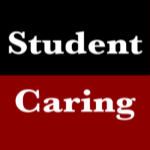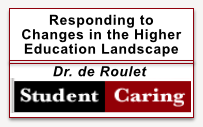Dr. Daniel de Roulet, PhD.
In his book, Everyday Survival, Laurence Gonzales describes a moment that we educators should recognize. Gonzales recounts piloting his small airplane on a planned route from northern Illinois to Door County peninsula in Wisconsin on a morning that had seemed tailored for flying. Having made the trip many times, and intending to meet his spouse and two daughters at a vacation rental, Gonzales recounts how he called the FAA and was assured of good weather—that he made a mental model of how the flight would unfold. This model was so strong that he did not even make a conscious decision to ignore the dark line on the horizon that gradually grew into barrier of storm clouds. Finally he was jarred out of his preconceptions by a report from another flyer of severe weather ahead—and he realized that the squall line was only a few miles away, with a lake below him. “All at once,” he writes, “I comprehended that I was doing something remarkably stupid. I was flying my tiny blue airplane with the happy stars on its tail into a black wall of explosive energy that extended from the surface of the water all the way to the heavens.” He was able to make a hard bank before he hit the storm, land his plane on a small airstrip, and pull into a hanger just as the now green-black sky exploded with lightning and hailstones.
Why should we educators recognize this experience? Firstly, because this is how many of us make it through the day. This kind of mental script or model allows part of one’s mind to operate in the background, taking care of details that would make a task virtually impossible if we had to attend to all of its details: this goes from driving, to typing, to depending that the school calendar we have operated under all semester has not suddenly changed. It allows our conscious minds to focus on the higher tasks of working through the materials we teach or research. Secondly, this kind of mental scripting works on an institutional level. It allows us to anticipate the sorts of students who will enroll in our classes; it allows us to plan on a long-term basis the courses we will teach and academic and creative projects we will pursue, and how our institutional resources are spent.
Finally, we are on the brink, I believe—intelligent people that we are—of doing something incredibly stupid. The behavior Gonzales describes also may lead to disasters, from the ridiculous to the sublime. The same pattern thinking that allows us to drive does not prepare us for when suddenly all the cars in front of us come to a screeching halt. It may lead to embarrassing moments of “absent-minded-professor” syndrome, when we are so intent our lectures that we walk into to desk that shouldn’t be in the front of the room where we usually pace. This thinking does not tolerate interruptions, such as a student who wants to see us outside office hours.
It also may lead and has more recently led to disastrous personal and institutional consequences when the mental scripts we have known all through our lives—dependable state budgets, compounding college endowments and retirement funds, secure knowledge that students will afford and need the kind of education we have to offer—turn into scripts that none of us planned for, even though we likely should have seen them coming. As a colleague of mine said of the California state budget crisis that has driven up tuition and driven down educational access, “This train has been coming down the track for a long time.”
Such unplanned disasters—such academic “squall lines”—do not affect academic gatekeepers alone, but our students—perhaps especially our students. Their entire mental scripts from kindergarten onward have been school, and college has been the expected final Scene to that first Act of their lives. But the script is in the middle of a sea change. To apply Laurence Gonzales’ analogy differently, it’s a bit like a third of the student body showing up to school unprepared for the unseasonable rainstorm suddenly sweeping down on campus, with lightning and hail and dangerous winds.
They are unprepared for such weather, and the support services that have been there to help them have become overwhelmed. At my academic institution of 12,000 students, there is a month-long waiting list to see a counselor. For the last two semesters, waiting lists for courses have been larger than class sizes. Parents can no longer draw out home equity to pay for college; those who have saved well find that their savings are not enough to cover tuition and books. Thirty percent of our students are going to school full-time and working at least thirty–five hours per week. Qualified students, shut out by state schools and shrinking family resources, are spending their first two years at community colleges like mine, while the state eliminates the intellectual exploration that has long been at the center of college life with budget-efficient “academic plans” that move them through my school as quickly as possible. Good jobs are hard to come by, before, during, and after college.
Simply put, we have entered into a scarcity model of education. Scarcity scenarios reduce resources, eliminate curricular requirements in ways that change the core of education, and look for scapegoats. They also make us look defensively inward, to guard our time and our turf, and encourage us to lose sight of the priorities of our profession. Over the last year, Prof. David Pecoraro, a colleague from a local four-year private university, and I, have been working on what we have named the Student Caring Project. In response to one of our podcasts, a director of first year programs at the University of California stated, “It is a very difficult time in California Higher Education. Our only hope is to pool resources and techniques. We have to do our best work to help our students as they make their way to graduation and a tough job market.”
What all this demands is a new way of thinking about college: not just by students, but by educators; not just on the classroom level, but on the institutional level.
When I was an undergraduate, now too many years ago, I did not have tremendous financial support or family encouragement for education; but, I did have strong peer relationships and few distractions. I came to college anxious to be an adult; educational costs were such that I was free to concentrate on intellectual exploration and rigor; although the job market was not strong when I graduated, my degree gave me a significant leg-up into a job that used my learning and promised a career—I also had access to graduate school when I determined that such a career could well drive me crazy.
The undergraduates I see today come to college anxious about being adults—they seem either like non-swimmers who have been thrown into the deep end of the pool, or like non-swimmers whose parents won’t get out of the damn pool to let them learn to swim. They work ridiculous hours and intellectual exploration and rigor suffer; they often come from overwhelming home situations that not only offer them little support but demand support from them; the jobs for which their degrees qualify them are often entry-level without assurance of a career; they leave school with significant loan debt. Fifty percent of them do not graduate.
I hear a number of my colleagues express regret and frustration that more and more of our students are not prepared, intellectually and developmentally, for college. I have joined in the lament, but we often misinterpret the reasons for this lack of preparedness and misinterpret the behaviors that go with it. More importantly, given the amount of time we spend each week with our students, and understanding that we might be some of the only adults in their lives to spend such quality time with them, we need to decide how to react to their needs in order to help them become better students and successful adults.
My answer is that, despite whatever reasons I might have had for becoming a college professor, the world of college that I thought I had entered has radically changed. I have decided that if I want to participate in educating, and not just in dispensing information to those who already have the means to receive it, then I must be aware of the obstacles to my students’ education and apply strategies to help them succeed. This means investing more time (or different kinds of time) into my students. To not do this is like building great highways for cars that do not have wheels. To not do this is to engage in the kind of pattern thinking that Gonzales describes and to fly our small planes into severe thunderstorms. Our students, unprepared for the weather they now face, will likely crash. And we will crash with them. Many of us have strategies for helping students to become better students and more successful adults; I believe we need to share our strategies and rethink how college now works.
This of course leads to institutional questions as well. I believe that we also need to become, and to find, advocates for allowing teachers and professors time and resources to become better guides for our students. This means concentrating shrinking university resources on the educational success of our students rather than on turf and territory. It means freeing faculty from committee work that is performed for the sake of filling out committee rosters or arbitrary “service” requirements. (I speak of this from years of experience as a dean and associate provost as well as from a professor’s point of view.) It means supporting faculty education in areas such as curriculum, pedagogy, and student development. It will mean the willingness of college and university presidents and vice presidents to rethink how resources are spent—to avoid “easy cuts” of courses and class sections, and to understand that the professor is often the first and primary contact for the student. It means attempting to reduce the cost of tuition and fees before financial aid. It means training professors to take on the role of advisor and mentor for students making the transition from college to life beyond. It does not mean tinkering around the edges of education, or gutting education’s core through draconian budget cuts, but it means rethinking and redesigning education by educators, with the classroom as the center of the college experience.
One more analogy is appropriate in closing. Higher education is a bridge connecting the pre-college and post-college worlds. Those worlds and their locations change. When I was an undergraduate, the pre-college side of the bridge was remarkably lacking in diversity—it was overwhelmingly full of white, upper and middle class eighteen-year-olds seeking education for careers, whose academic preparedness and expectations for college could be counted on at basic levels. The pre-college world now boasts a more robust and complicated population, and the landscape itself has changed. One can have beautiful bridges to nowhere. One can also rebuild bridges, understanding the needs of the worlds on both sides, and the needs of the people engaged in crossing from one side to the other.
Copyright 2012 by Daniel N. de Roulet and The Student Caring Project


